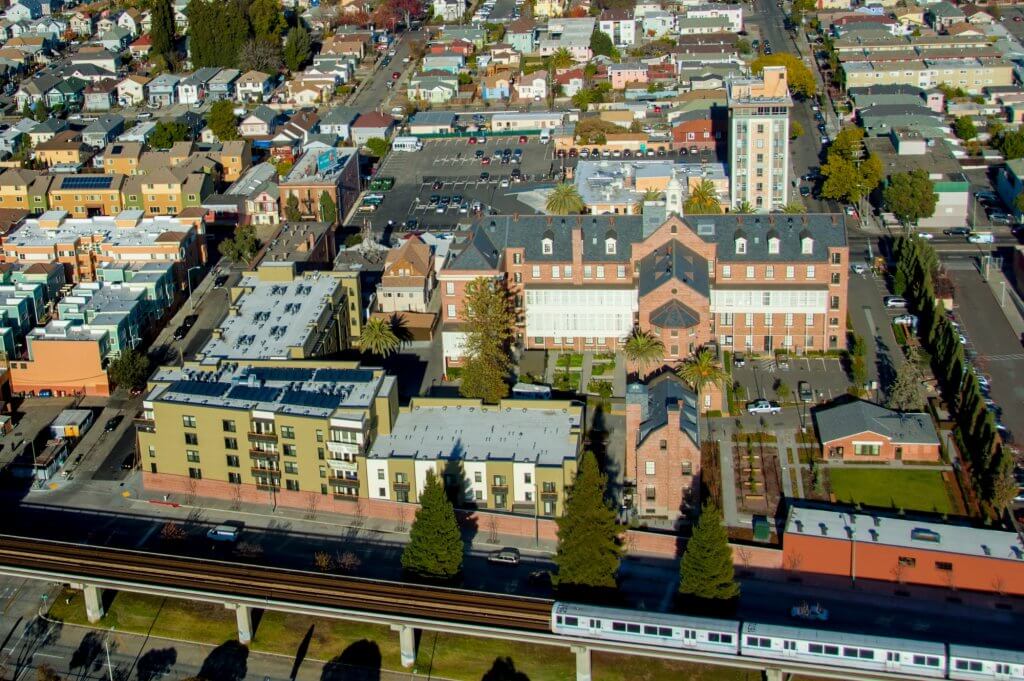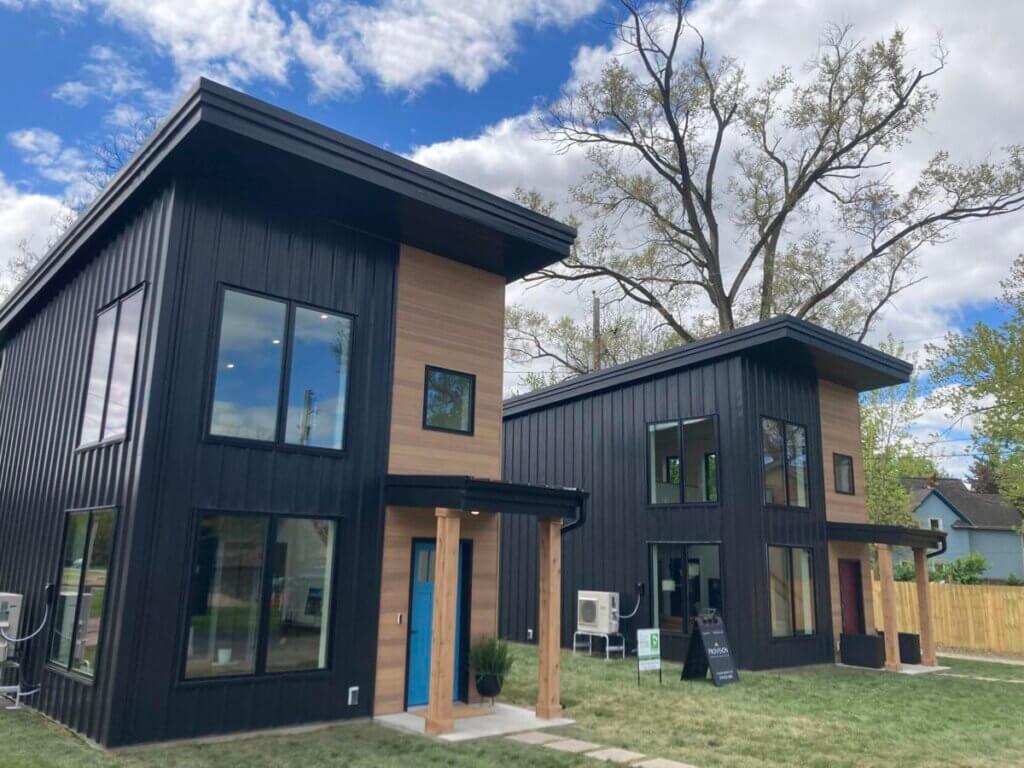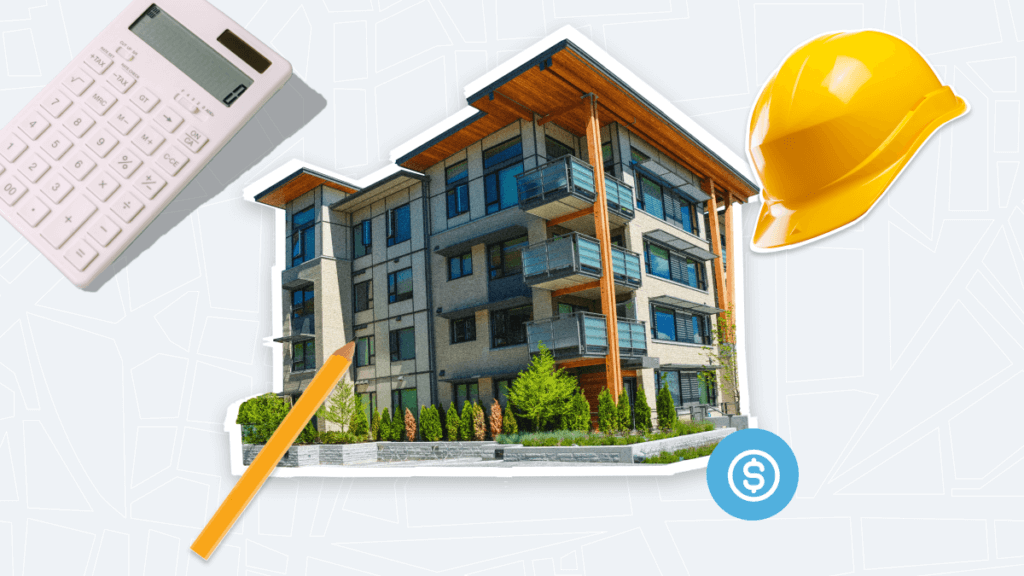Understanding the Drivers of Construction Costs in California
Published On January 16, 2018
As construction costs continue to rise across the country, experts have failed to reach a consensus about the exact causes of these increases. The Terner Center for Housing Innovation conducted an analysis of single family and multifamily residential projects in California to identify how regulations, labor markets, and industry inefficiencies contribute to rising construction costs. The goal of the project was to identify opportunities to reduce costs, which can help to expand the supply of housing and increase the impact of public subsidies for affordable developments.
For more information on the study, see The Hard Costs of Construction: Recent Trends in Labor and Materials Costs for Apartment Buildings in California.
BACKROUND ON THE STUDY:
The costs of construction are rising rapidly, especially in California. The cost of building has recovered from the recession and continues to escalate, making many potential housing projects prohibitively expensive. San Francisco and Oakland are currently ranked second and third for construction costs nationwide, and those costs are rising quickly.[1] Between January 2011 and January 2016, construction costs rose by 12.6% in San Francisco, 13.6% in Los Angeles, and 11.8% nationwide.[2] In the past year the national single-family construction price index increased by 5.6%, compared to an average annual increase of 2.7% between 1990 and 2000 (Graph 1).[3] Similarly, the multifamily price index rose by 6.2% in 2015, a rate that exceeded the previous 9 years (Graph 2).[4]
Graph 1:
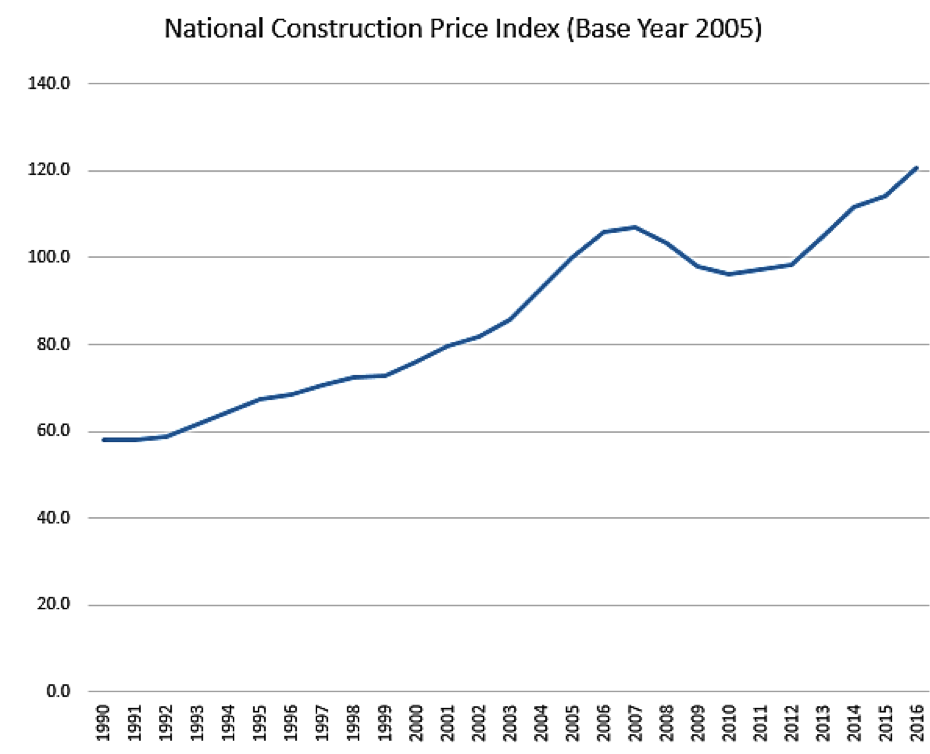
U.S. CENSUS BUREAU, LASPEYRES PRICE INDEX- SINGLE-FAMILY HOUSES UNDER CONSTRUCTION
Graph 2:
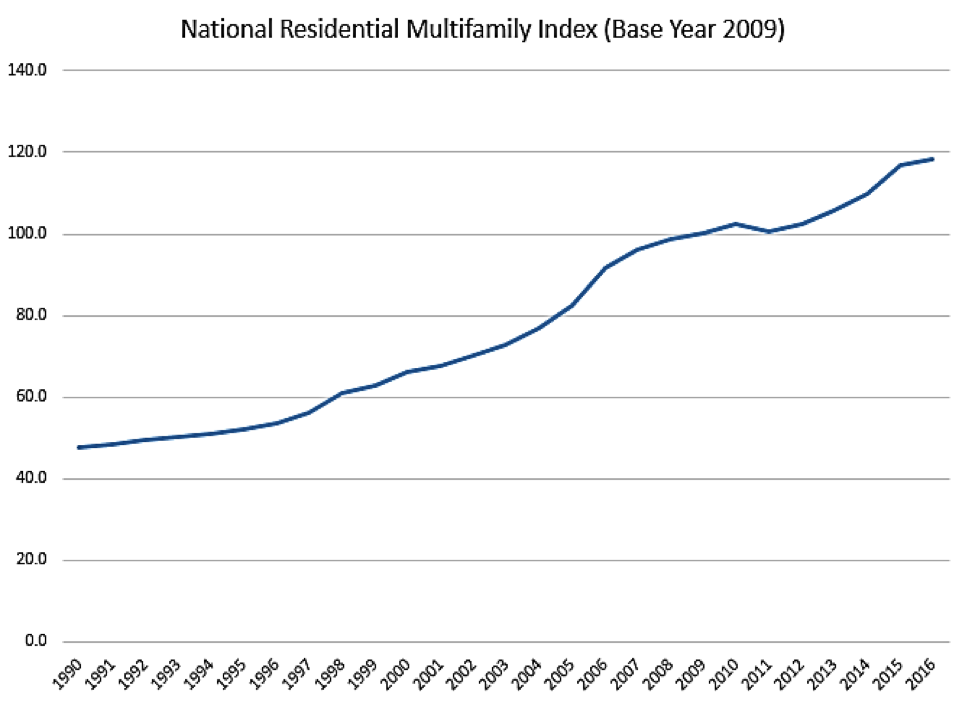
U.S. BUREAU OF ECONOMIC ANALYSIS, REAL PRIVATE FIXED INVESTMENT: RESIDENTIAL: STRUCTURES: PERMANENT SITE: MULTIFAMILY
At the same time, the construction industry’s productivity has been in decline. Unlike other sectors of the economy, residential housing is still being built in the same way as it was fifty years ago. The McKinsey Global Institute argues that innovations such as value engineering, standardized designs, and prefabricating components could encourage productivity and reduce construction costs by about 30% worldwide (Graph 3).[5]
Graph 3: Labor Productivity in U.S. Construction
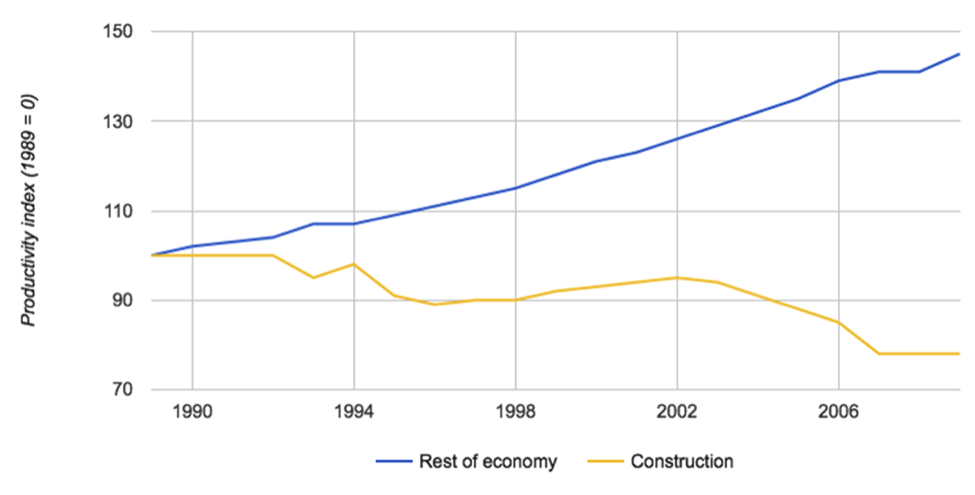
U.S. MCKINSEY GLOBAL INSTITUTE, TACKLING THE WORLD’S AFFORDABLE HOUSING CHALLENGE, OCTOBER 2014
Public policies to reduce the cost of construction need to be informed by better data. Data on rising construction costs tend to group together projects of very different designs and characteristics, making it difficult to know what influences costs. In addition, prevailing wages, local building codes, and/or impact fees are trying to achieve important policy goals, yet may inadvertently be contributing to California’s housing crisis. Understanding the costs and benefits of the various components of the construction process can help policy-makers make better decisions about what to prioritize.
STUDY APPROACH AND METHODOLOGY:
In this project, the Terner Center is focusing on three factors that influence construction costs:
1. Regulation: How do local land use regulations and/or building requirements contribute to rising construction costs? While research has linked higher housing costs to more restrictive land use policies,[6][7][8] there is less evidence for how local building requirements influence construction costs. By comparing similar projects in different jurisdictions, the Terner Center will identify the role of local regulations and fees on current construction pricing.
2. Market Dynamics: The residential construction labor force contracted sharply in the wake of the recession, and is still recovering (Graph 4). In addition, many materials required for construction have become more expensive in recent years. While the overall market declined between 2015 and 2016, construction materials such as glass and cement prices increased by more than 5%.[9] In the last year, material prices increased by 4.8% overall.[10] Project level data will allow Terner Center researchers to tease out the role of both labor market factors and the price of materials on rising construction costs.
3. Construction Efficiency: The construction industry has remained relatively small after the great recession. Anecdotal evidence suggests that the diminished number of subcontractors, in particular, cannot meet the demand for housing construction. By reviewing bid schedule and cost estimates with final schedules and costs as delivered, the Terner Center hopes to identify potential points of improvement regarding construction efficiency. The Mckinsey Global Institute highlighted the importance of increased productivity in achieving affordability, estimating that construction costs must fall by more than 30% nationwide to build market rate housing that is affordable for those earning 80% of the area median income or more.[11]
Graph 4:
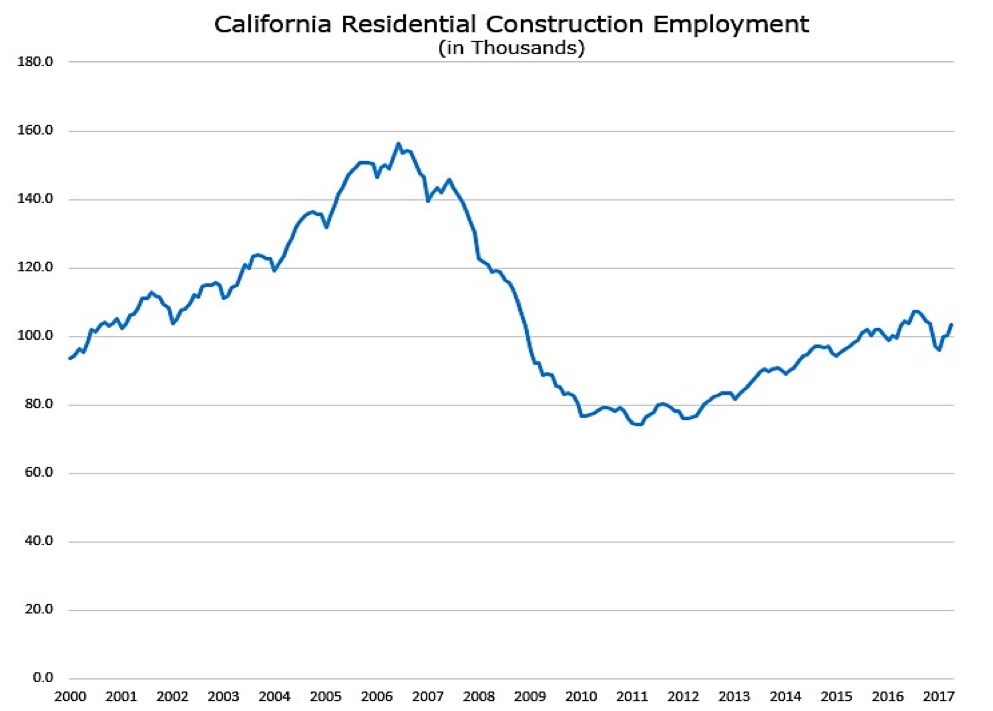
BUREAU OF LABOR STATISTICS, OCCUPATIONAL EMPLOYMENT STATISTICS
As part of this research project, the Terner Center is conducting interviews and surveys to gather project level information from developers, general contractors, and subcontractors across the state. We are also analyzing data on Low-Income Housing Tax Credit (LIHTC) projects to better understand trends for affordable housing projects. This project also will support ongoing work on the Housing Dashboard, as well as the Terner Center’s efforts to understand how local land use regulations influence housing supply.
[1] “Construction Outlook, United States, Q4 2016” JLL. 2017.http://www.us.jll.com/united-states/en-us/research/us-construction-perspective.
[2] Andrea Cross, and Taylor Jacoby. “Why are Construction Costs Rising?” CBRE. June 2016. http://www.cbre.us/configuration/global/content/globalresearch/3/5/0/9/4/35094.
[3] “Price Indexes, Single-Family Houses under Construction” U.S. Census Bureau.
[4] U.S. Bureau of Economic Analysis, Real private fixed investment: Residential: Structures: Permanent site: Multifamily (chain-type price index) [B292RG3Q086SBEA}. FRED, Federal Reserve Bank of St. Louis. Last modified June 15, 2017. https://fred.stlouisfed.org/series/B292RG3Q086SBEA.
[5] Jonathan Woetzel et al., “A Blueprint for Addressing the Global Affordable Housing Challenge” Mckinsey Global Institute. October 2014. http://www.mckinsey.com/global-themes/urbanization/tackling-the-worlds-affordable-housing-challenge.
[6] John Quigley, and Larry Rosenthal. “The Effects of Land Use Regulation on the Price of Housing: What Do We Know? What Can We Learn?” Cityscape 8, no. 1 (2005): 69-137. http://www.jstor.org/stable/20868572.
[7] Jenny Schuetz. “Land Use Regulation and the Rental Housing Market: a Case Study of Massachusetts Communities.” Joint Center for Housing Studies, Harvard University. Prepared for Revisiting Rental Housing: A National Policy Summit. March 1, 2007. http://www.jchs.harvard.edu/research/publications/land-use-regulation-and-rental-housing-market-case-study-massachusetts.
[8] Edward L. Glaeser and Joseph Gyourko. “The Economic Implications of Housing Supply.” Samuel Zell and Robert Lurie Real Estate Center, Working Paper #802. January 4, 2017. http://realestate.wharton.upenn.edu/working-papers/the-economic-implications-of-housing-supply/.
[9] Cross and Jacoby, “Why are Construction Costs Rising?”
[10] “Construction Economic Update.” Associated Builders and Contractors, Inc. March 2017. http://www.abc.org/NewsMedia/ConstructionEconomics/ConstructionEconomicUpdate/tabid/270/entryid/8282/construction-input-prices-expand-for-third-straight-month-petroleum-prices-soar-year-over-year.aspx.
[11] Woetzel, “Addressing the Global Affordable Housing Challenge.”



